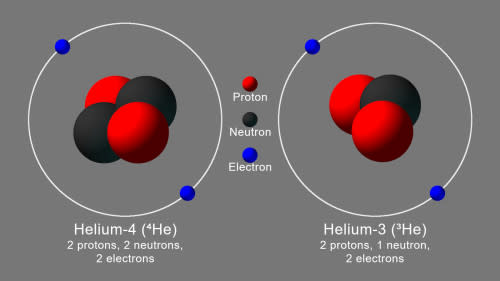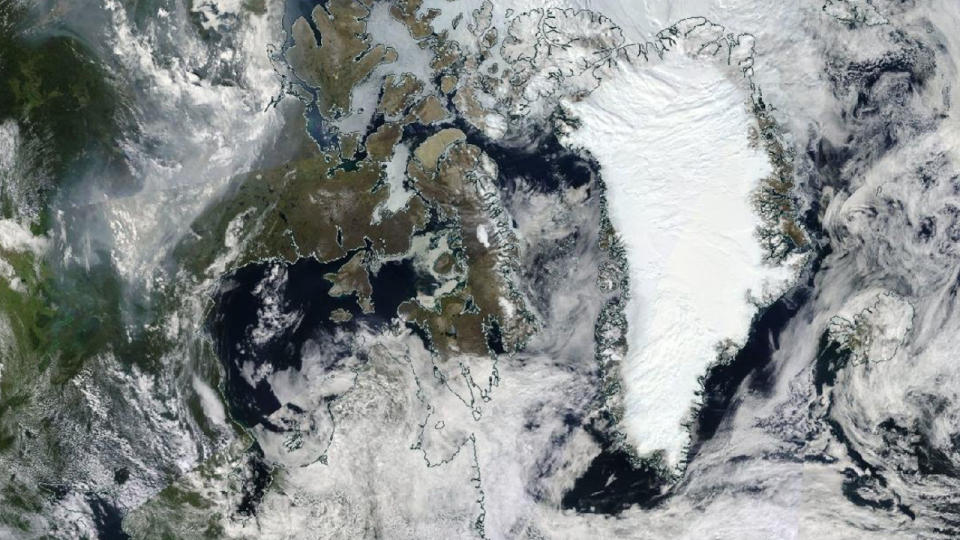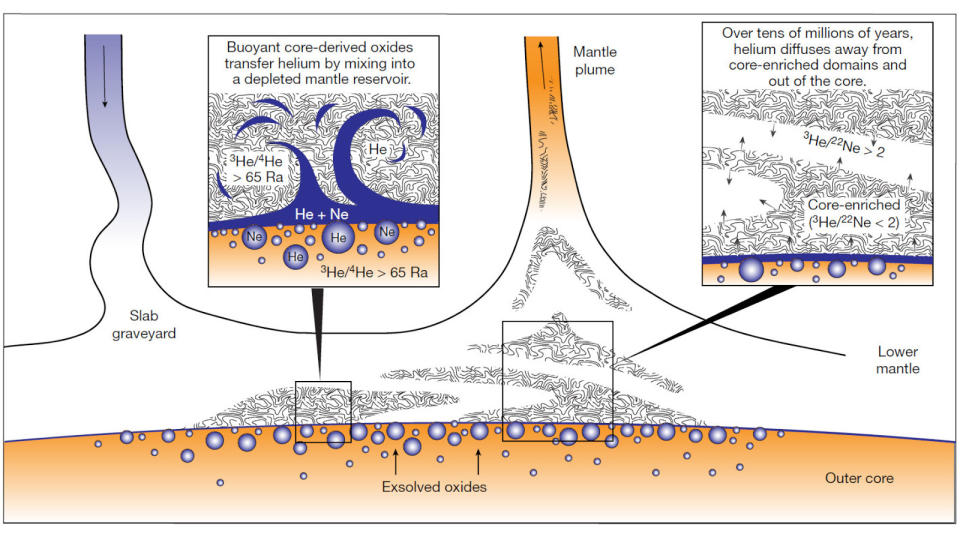Baffin Island rocks point to rare form of helium leaking from Earth's core

Tapping into volcanic rocks on Baffin Island, researchers discovered high concentrations of a rare isotope of helium, which appears to have leaked to the surface from Earth's core after being trapped there when the planet first formed.
Around 4.6 billion years ago, a giant nebula of gas and dust collapsed to produce our solar system. One of the gases in that nebula was helium, the second most abundant element in the universe after hydrogen. A typical helium atom has two protons and two neutrons in its nucleus (helium-4). However, just through natural processes, roughly 1 in every 10,000 helium atoms was an isotope with two protons and only one neutron (helium-3).

The basic atomic structure of Helium-4 vs Helium-3. Helium-3 is a 'stable isotope', meaning that it has a different number of neutrons than the typical atom of that element, and it will never undergo radioactive decay. Credit: Scott Sutherland
As the Earth formed, it is thought that helium-4 and helium-3 flowing on the solar wind became trapped in the minerals of the cooling planet. With heavier elements and minerals sinking to the bottom, this trapped helium was transported to the core, where it would have remained locked in its original forms.
Earth isn't massive enough to hold on to helium in any significant quantities, though. Any that did not get trapped, or that was subsequently released when the minerals melted in the mantle or due to massive impacts, would have eventually seeped up to the surface and floated off into space. So, helium is relatively rare on Earth, and helium-3 is even more so.
However, researchers have found an abundance of both helium-4 and helium-3 trapped in the volcanic rocks on Baffin Island.

This view of Canada's north was captured during multiple passes by NASA's Terra satellite using its MODIS instrument. Credit: NASA Worldview
According to a new study published in the journal Nature, this began around 20 years ago, when helium-3 to helium-4 ratios roughly 50 times higher than what is found in Earth's atmosphere were discovered trapped in olivine crystals (aka peridot) in lava deposits found on Baffin Island. The 2023 study details the findings of a 2018 expedition to the region by scientists from the Woods Hole Oceanographic Institution and the California Institute of Technology and their discovery of the highest helium-3/helium-4 ratios on Earth so far — between 65 and 69 times the atmospheric ratio.
"Our high 3He/4He measurements imply that gases, presumably inherited from the solar nebula during solar system formation, are better preserved in Earth than previously thought," Forrest Horton, the lead author of the study from the Woods Hole Oceanographic Institution, told CNN.
The lava deposits of Baffin Island were formed 50-60 million years ago when Greenland split off from North America. According to the researchers, the high ratio of helium-3 to helium-4 suggests that lava originated from a mantle plume that rose from deep within the Earth to fill the gap created during that split. Mantle plumes are regions of extremely hot magma that rise through the mantle and crust and could carry helium trapped in the core to the surface.

Buoyant exsolved oxides from the outer core may mix into a lowermost mantle reservoir composed of subducted depleted mantle (that is, a slab graveyard). Mantle enriched by core-derived material might inherit high 3He/4He from the core. Over tens of millions of years, core-derived He may then diffuse into the surrounding depleted mantle. Both domains—one enriched by core-derived oxides, the other by He diffusion—may become incorporated into mantle plumes, like the Iceland plume that produced the Baffin Island lavas. Credit: Horton, et al., 2023/Nature
"During the eruption, the vast majority of the gases in the magma escaped to the atmosphere," Horton told CNN. "Only the olivine crystals that grew prior to eruption trapped and preserved the helium from the deep Earth."
"The lavas are about 60 million years old, and the ascent of the mantle plume took perhaps tens of millions of years," he explained. "So, the helium we measured in these rocks would have escaped the core perhaps 100 million years ago or possibly much earlier."
While the research team says that it's possible the helium they found could originate from Earth's mantle, they believe the core is a much more likely source.
If true, this discovery could present scientists with a new way to study Earth's core, a part of our planet that is next to impossible to study by any direct means.

The rugged terrain of Pangnirtung, on Baffin Island's Cumberland Peninsula, could hold clues to studying Earth's core. Credit: Ansgar Walk/Wikimedia Commons (CC-BY-2.5)
"This area on Baffin Island holds special importance both as sacred lands for the local communities and as a scientific window into the deep Earth," Horton told CNN.
"Many of the lavas are full of bright green olivine (also known as the gemstone peridot), so breaking off fresh pieces with a rock hammer was as thrilling as breaking apart geodes as a kid: each rock was a treasure to be discovered," he said. "And what scientific treasures they turned out to be!"
(Thumbnail courtesy NASA's Jet Propulsion Laboratory)

